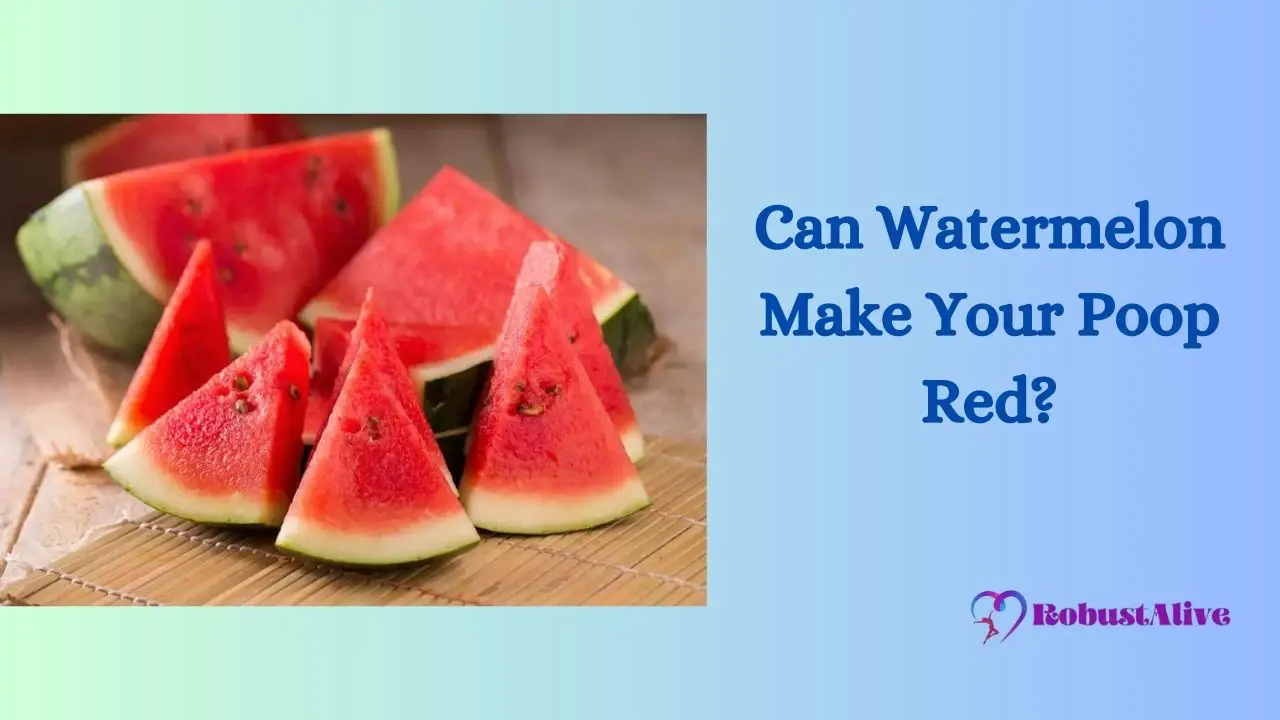Can Watermelon Make Your Poop Red?

Red stools might be unsettling, but not all red stools are a cause for worry. Consuming some meals containing natural or synthetic pigments frequently results in red stool.
But can watermelon make your poop red?
Yes, it can change the color of your poop and turn it red. The natural pigment lycopene found in watermelon can turn your poop red. Lycopene from watermelon enters your system through your food and can be broken down by gut flora. Your faeces may look red as a result of this procedure. Typically, it is a brief episode and stool color returns to normal.
So, keep reading to discover more details about why watermelon makes your poop red and more informative facts regarding this.
Can Watermelon Make Your Poop Red?
Yes, watermelon may turn your stool red. Lycopene, a natural pigment found in watermelon, gives the refreshing and delectable fruit its vivid red color. Lycopene can travel through the digestive system mostly intact, even if it is not readily absorbed by the body.
The lycopene can make its way to the large intestine, where the gut bacteria may cause it to undergo alterations. Lycopene may degrade due to these modifications and release pigments. These pigments might give the stool a red or pink color. This innocuous phenomenon does not necessarily signify any health problems.
You most likely have watermelon pigments in your digestive tract if you see red-colored stools after eating watermelon.
Read More: Foods to Avoid with Trulicity
Why Does Watermelon Make Your Poop Red?
As you already know from the above-mentioned information, if you consume too much lycopene, you will notice redness in your poop. Let’s try to figure out what happens when you overeat watermelon.
Lycopene travels through your digestive system after being taken in high amounts. In the next stage, it interacts with gut flora. After this, it causes the production of pigments that develop a reddish hue in your stool.
Therefore, overeating watermelon actually causes you to consume too much lycopene. Here is a more thorough explanation of why watermelon makes you poop red:
Decreased Digestive Enzyme Resistance:
Lycopene is comparatively resistant to the body’s digestive enzymes. As a result, a sizeable part of the lycopene consumed in watermelon passes through the digestive system undamaged.
Gut Bacterial Interaction:
Lycopene can interact with the gut bacteria found in the colon in the large intestine. Through a procedure called fermentation, the bacteria can degrade the lycopene. Lycopene releases pigments and metabolites, some of which are red or reddish-brown in hue.
Red Pigment Release:
Gut bacteria may break down lycopene, which can produce other chemicals, including pyrroles. Together with other metabolites, these pigments can color feces in bloody red.
Depending on the individual, high lycopene ingestion may affect feces color differently. While some people might notice a more noticeable shift in stool color, others might not detect anything at all. The degree of the red color in the feces might vary depending on the amount of lycopene taken, its concentration in the meal, and each person’s unique mix of gut flora.
Also Read: Why am I So Tired with Diverticulitis?
Can Watermelon Cause Red Poop in Toddlers?
Yes, toddlers get reddish feces from watermelon. The cause of this is that toddler’s intestines might not be as developed as adults’. That’s why breaking down the meal is challenging for them. Lycopene in watermelon can pass through toddlers’ digestive systems entirely intact.
The gut bacteria can occasionally cause the lycopene to change in the large intestine. After that, it releases pigments that can give the feces its red hue. Overall, eating watermelon can be highly beneficial. This keeps toddlers stay hydrated.
How to Tell The Difference Between Blood And Watermelon’s Redness in Stool?
Understanding the actual cause of the redness in the feces is critical. After enjoying eating watermelon, you could get red stools. However, to be sure about the causes of the redness of stools, you can examine the stool using the following criteria:
Consistency:
Discoloration from watermelon is usually consistent and spreads throughout the stool. On the other hand, blood in the stool might have a distinct texture and could show as streaks or dots.
Timeframe:
The redness of stool caused by watermelon pigment often goes away in a day or two. If the redness lasts or if it is accompanied by other symptoms, consult a doctor.
Symptoms:
If you experience symptoms such as cramping with blood in the stool that is unrelated to eating watermelon, talk to a Doctor. These might be indications of a more severe condition.
Lycopene in Watermelon
The carotenoid family of natural pigments, includes lycopene, a potent antioxidant. It gives some fruits and vegetables, including watermelon, their vivid red or pink color. Watermelon has high concentrations of lycopene. That’s why watermelon is an excellent source of antioxidants.
Essential information regarding the lycopene in watermelon is provided below:
Chemical Makeup:
Forty carbon atoms and many hydrogen atoms comprise the linear molecule called lycopene. Its rich red hue results from a sequence of conjugated double bonds that comprise its chemical structure.
Antioxidant Properties:
Lycopene is renowned for its antioxidant properties. It aids in defending cells from harm brought on by free radicals. By neutralizing free radicals, lycopene can help reduce oxidative stress and inflammation in the body.
Benefits Regarding Health:
By lowering cholesterol levels, lycopene may help reduce the risk of cardiovascular illnesses. It also improves blood vessel function and inflammation of the cardiovascular system.
Bioavailability:
As a fat-soluble substance, lycopene is best absorbed when combined with dietary lipids. Therefore, you can improve lycopene absorption by including healthy fats like avocado in a meal or salad that contains watermelon.
Nutritional Synergy:
The synergistic effects of lycopene with other watermelon constituents, such as vitamin C and other antioxidants, can increase the fruit’s health advantages. Lycopene alone may not have as significant an effect on general health as lycopene combined with these nutrients.
List of Foods That May Cause Red Stool
We’ve compiled a list to help readers understand better about food items that might result in red stool:
| Food Name | Causes for Red Stool |
| Red Gelatin | Red gelatin can include artificial food colors that can temporarily turn stools red. |
| Beets | Beets contain betalains pigments that can cause the feces to become red. |
| Red Peppers | Red peppers’ natural pigments, such as capsanthin, can cause red stools. |
| Red-colored Drinks | The use of beverages like fruit punch, red sports drinks, or artificially colored sodas may cause red stools. |
| Red Food Coloring | Red food coloring in some meals and beverages might result in red stools. |
| Tomato | The component lycopene is responsible for the red color of the feces. |
| Cranberries | Occasionally, eating a lot of cranberries might cause red stools. |
| Red Food Products | Certain processed meals, such as red liquorice or candy tinted red with food coloring, might cause red stools. |
| Red Watermelon | Lycopene, which is present in watermelon and can turn the feces red, especially in higher concentrations. |
| Dragon Fruit | Red stools may result from the natural colors of dragon fruit, especially the red-fleshed species. |
Should You Be Concerned If You Pass Red Stool?
Ultimately, paying attention to your health and any persistent changes in stool color, especially if they’re connected to other symptoms, is essential. It is always recommended to seek medical counsel if you are unsure of the reason for red-colored stools.
We have included a few potential causes of passing red stools for the benefit of our readers so that you may assess your issue.
Medications:
Red-colored stools are another side effect of several drugs and supplements. For instance, taking iron supplements or drugs containing bismuth subsalicylate might cause red color of the stools. Check the side effects of any drugs or dietary supplements. It will give you clarity if they could be the cause of the bloody stool.
Diet:
The ingestion of particular foods or food coloring is one of the most frequent causes of red stool. Your feces may seem red if you eat foods like beets, tomatoes, red gelatin, or meals that contain red food colors. If you recently ingested such things, then your red stool is only a byproduct of your diet.
Gastrointestinal Bleeding:
Gastrointestinal bleeding is the most significant reason for red stools. Inflammatory bowel diseases, ulcers, hemorrhoids, diverticulosis, and even some cancers can result in bleeding in the digestive tract. Depending on where the bleeding is occurring, blood in the digestive tract might mix with excrement and make it seem red or black.
Hemorrhoids:
Swollen blood vessels in the anal region are hemorrhoids. They occasionally bleed, leaving bright red blood on the toilet paper or on the stools. Hemorrhoids are often not a serious condition, It is advised to see a doctor if the bleeding continues.
Read More: How Rapid is Weight Loss with Farxiga?
Frequently Asked Questions (FAQs)
Can Watermelon Cause Diarrhea?
In general, watermelon doesn’t cause diarrhea. In fact, watermelon will keep you hydrated and refreshed because of its high water content. Additionally, it includes fiber, which supports good digestion and can help control bowel motions. Individual responses to food can differ. Though, some people can be more sensitive to specific fruits or feel ill after eating watermelon.
Can Watermelon Make You Constipated?
Watermelon is a fruit with high fiber content. It helps to ensure healthy and regular bowel movements. So it doesn’t cause constipation.
Can Undigested Food Seem Like Blood in Stools?
Yes, occasionally, undigested food can seem like blood in feces. Certain meals can retain their original look and color, which may be mistaken for blood. It’s crucial to remember that blood in the stool should not necessarily be interpreted as uneaten food. Consult a medical expert for a thorough examination
Conclusion:
Can watermelon make your poop red? The presence of the lycopene watermelon can cause your excrement to become red. This red stool doesn’t happen because of any kind of sickness. It happens because of lycopene pigment.
So, there is nothing to be worried about if you pass red stool after eating watermelon.
If you pass red poop only because of eating watermelon, it will stop as soon as you stop eating the fruit. But if it doesn’t stop, you must visit a doctor.





